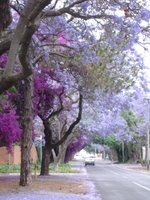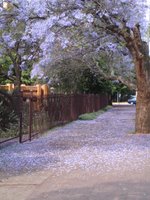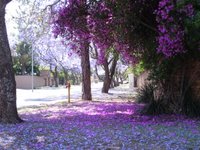
Pine Caterpillars (Latin name thaumetopoea pityocampa) are probably one of the most unpleasant creatures you will find in this part of the world where pine trees grow in abundance. They are found throughout the warmer regions of Southern Europe, the Near East and North Africa. As well as causing much damage to pine forests, they are a major danger to animals and, to a lesser degree, human beings.
The very fine hairs on these creatures are poisonous and most dangerous. When hungry, they leave their cocoon to seek another uninfested tree on which to feed. They travel nose to tail in a line, hence the name Processional. The caterpillars are often seen in the evenings, walking in procession from tree to tree.
If they drop onto you or your pet, don't brush them off with your hands because the effect is most unpleasant, causing great irritation, rash and pain. Dogs, cats and people can suffer from shock. The hairs of the caterpillars are still virulent even when the creatures are dead.
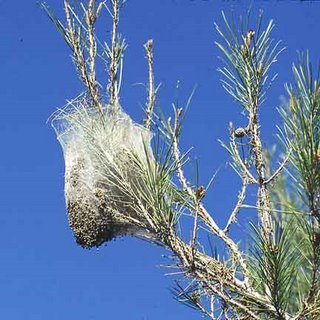
The pine processionary caterpillar is the best known of all the processionaries, studied as early as 1736 by Raumier and later by Fabre (1898) whose essay “ The life of the caterpillar” is among the classics of popular entomological literature. t is the habit of the caterpillars to move over the ground in long head-to-tail processions and to sting with urticating hairs anyone who attempts to molest them that has brought the caterpillars to the attention of the public. It is also one of the most destructive of forest insects, capable of defoliating vast tracts of pines during its episodic population surges. Of interest here, however, is the fact that is among the most social of caterpillars. Sibling groups stay together throughout the larvae stage, often pupating side by side at sites they reach by forming long, over-the-gound, head-to-tail processions.
The insect is active only during the colder times of the year, spending the warm summer months as a pupa buried in the ground. The moths begin to emerge from the soil in August and shortly thereafter mate and seek out pine trees where they place their eggs. Each female produces a single egg mass which it fastens to a needle of a suitable host trees. Egg masses contain up to 300 or so eggs and the caterpillars typically eclose from them four or more weeks after they are laid. The eggs are completely covered with scales that detach from the abdomen of the female.
Despite their small size, the newly hatched caterpillars have remarkably strong mandibles and are able to penetrate the tough needles of the host from the start.
They caterpillars are highly social. At first they are nomadic, spinning and abandoning a series of flimsy shelters constructed by enveloping a few needles in silk but in the third instar they initiate the construction of a permanent nest and settle down to become central place foragers. There are no definitive openings in the shelter that allow the caterpillars to enter and exit. Rather, the caterpillars force their way through the layers of the shelter as they move in and out. The frass that is produced as the caterpillars process their meals accumulates at the bottom of the shelter.
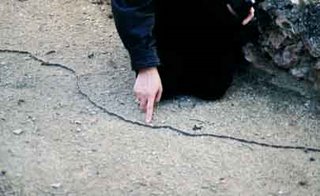
Colonies are active throughout the winter months. They feed overnight then return to the nest at dawn. Observations in mid-winter show that the caterpillars forage on the coldest of nights and are able to locomote, albeit very slowly, at sub-zero temperatures. The permanent nests are typically sited to intercept solar radiation and during sunny days warm to well above ambient temperatures. The caterpillars rest in the nest during the day and at the elevated body temperatures they experience due to heating of the nest by the sun are able to efficiently digest the food they collect overnight.
Recent studies show that the caterpillars lay down a trail pheromone as they advance over the branches of the host tree. The unidentified marker is secreted from the ventral surface of the abdomen. The caterpillars mark when the tips of their abdomens brush against the substrate. Although the caterpillars also secrete silk and mark their pathways with the material, studies show that it plays little or no role in the elicitation or maintenance of trail following. Most likely, silk serves to increase steadfastness on the smooth plant surfaces. Pine processionary caterpillars can distinguish old from new trails. They caterpillars also differentiate between trails made by different numbers of caterpillars and follow preferentially those marked by the most caterpillars. Trail marking enables the caterpillars to aggregate at feeding sites and allows them to find their way back to nest after feeding. When they move over the branches, the caterpillars may move head to tail in small groups or they may move completely independently of others. In either case, they rely on the trail marker to find their way.
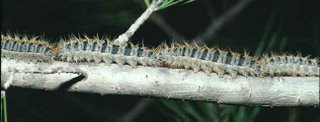
While the caterpillars may form single file processions as the advance over the branches of the host tree in search of food, the most spectacular processions are formed when the caterpillars are fully grown and abandon the host tree in search of pupation sites. Over-the-ground processions of as many as three hundred caterpillars have been observed. The caterpillars may travel long distances from the natal tree looking for soft soil in which they bury themselves and form their cocoons.
Studies show that during these head to tail processions, stimuli associated with setae found on the tip of the abdomen of the precedent caterpillar serve to hold processions together and such stimuli take priority over those associated with either the trail pheromone or silk. A caterpillar can be readily induced to follow a model made by attaching the integument of the abdomen of a killed caterpillar to a wooden dowel.
Should you come across any of these nests in the pine trees where you are, please contact the local Mairie immediately. They will come to destroy the nests as quickly as possible -- unfortunately often the only remedy is to saw off the branches in which the nests are found and burn them -- but rather a few deformed pine trees than completely stripped pines!
Click on Link:
Chateau Lalinde : The perfect venue for your event
TAGS: Events Rent a chateau France
Chateau
Perigord Food Holidays in France Recipes


